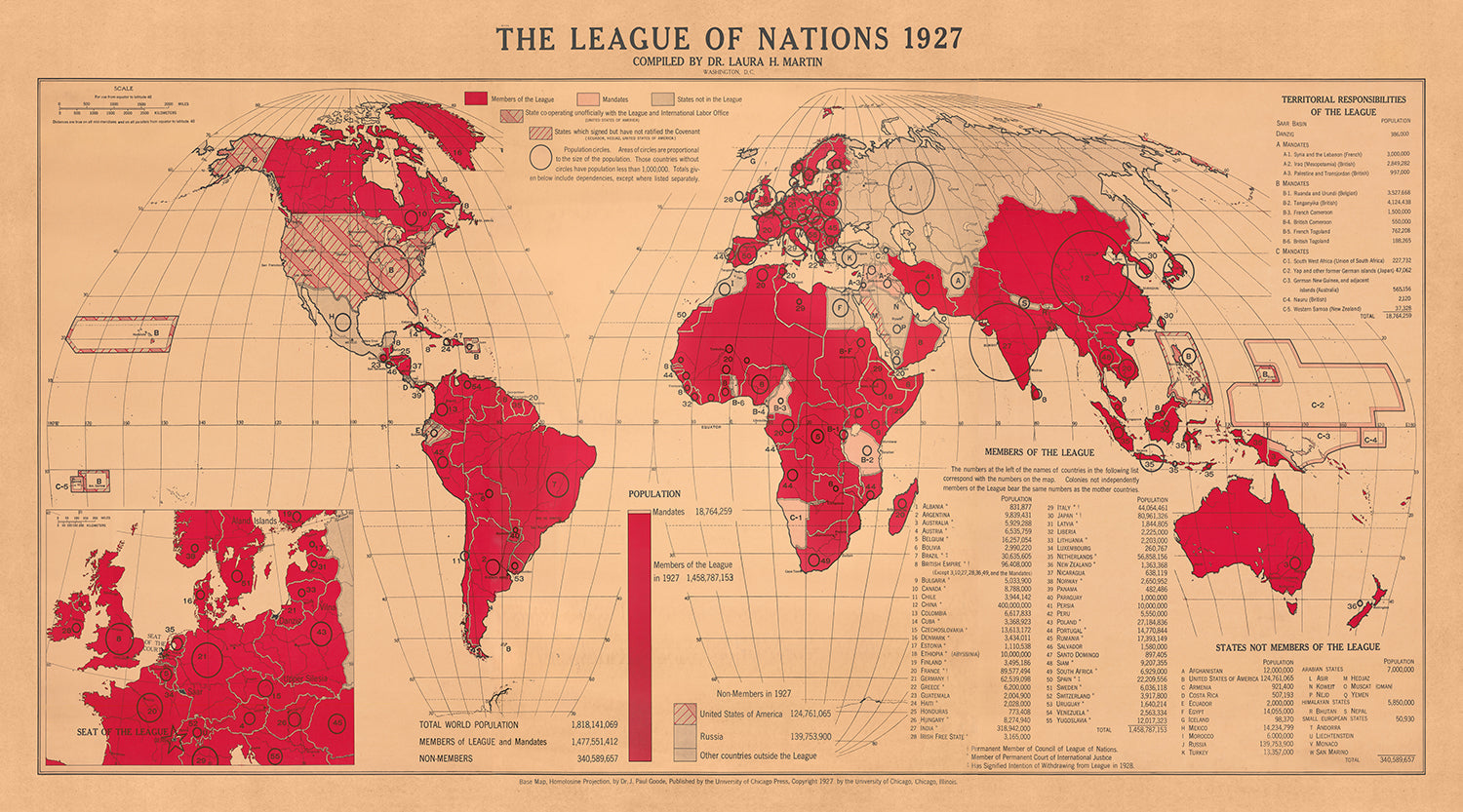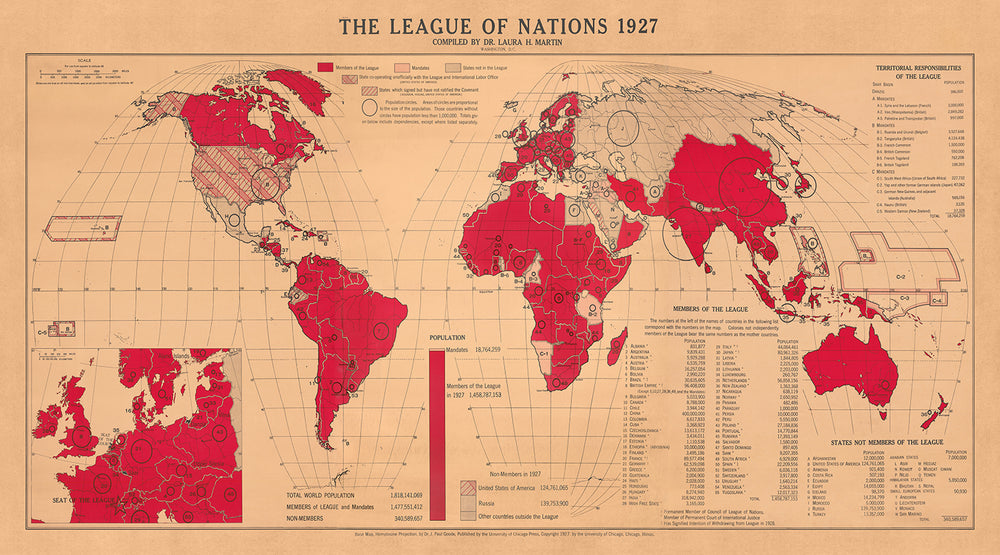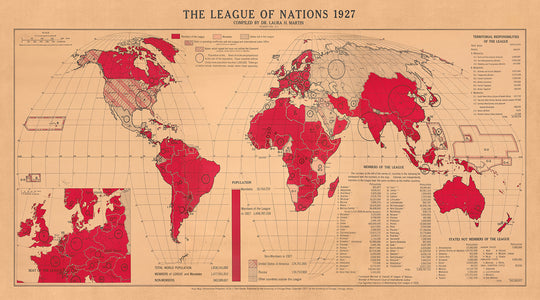- Handmade locally. No import duty or tax
- FREE Delivery by Christmas
- Love it or your money back (90 days)
- Questions? WhatsApp me any time
Own a piece of history
5,000+ 5 star reviews


Embark on a historical voyage with "The League of Nations 1927," a map that captures a pivotal moment in global diplomacy and politics. Crafted by the esteemed Dr. Laura Martin, a renowned academic and expert in polar regions, this map is more than a mere geographical representation; it is a testament to the era's aspirations for peace and cooperation following the devastating aftermath of World War I. Dr. Martin, alongside her husband Lt. Col. Lawrence Martin, significantly contributed to the cartographic and geographic knowledge of their time, marking their legacy with this detailed political map. Their work illuminates the intricate political landscape of the 1920s, offering a unique lens through which to view the world's attempt at unity and peace through the League of Nations.
This map stands out not only for its historical significance but also for its meticulous design and cartographic precision. Utilizing the Goode Homolosine or equal-area projection, it achieves a balance between the representation of landmasses, ensuring that each country's size is accurately depicted without distortion. The map's design elegantly delineates the boundaries of countries and their capitals, while also highlighting the League of Nations' headquarters in Geneva, Switzerland. The inclusion of a table showing the population of each country, alongside a list of the League's members, mandates, and non-member states, enriches the viewer's understanding of the global demographic landscape of the time.
"The League of Nations 1927" is not just a map; it is a vibrant narrative of the world in a period of transition. It showcases the global reach of the League, with 58 member states striving for peace, and details the mandates and territories under its guidance. The map is color-coded to distinguish between members, mandates, states not in the League, and those cooperating unofficially, such as the USA. This careful categorization provides a clear visual representation of the international relations and political affiliations of the era, making it an invaluable resource for those interested in the geopolitical dynamics of the early 20th century.
Dr. Laura Martin's map is a rare large-format artifact that serves not only as a tool for geographical education but also as a piece of historical art. Its detailed depiction of sea, road, and rail routes, alongside major cities, capitals, and notable geographic features like mountain ranges and bodies of water, offers a comprehensive view of the world's interconnectedness in 1927. The map's design and annotations convey a wealth of information, from the responsibilities of the League to the populations of countries, both members and non-members, highlighting the global scope of the League's influence and the diversity of its constituents.
In summary, "The League of Nations 1927" is a masterpiece of cartography and history, encapsulating the hopes and challenges of a world recovering from war and seeking a path toward peace through international cooperation. Its creation by Dr. Laura Martin, a figure of significant academic and cartographic accomplishment, adds to its allure, making it a prized possession for collectors, historians, and anyone fascinated by the intricate tapestry of global relations. This map is not just a visual representation of the world in 1927; it is a historical document that tells the story of the League of Nations' ambitious yet fleeting endeavor to unite a fragmented world.
Countries and regions on this map
- Abyssinia
- Afghanistan
- Albania
- Argentina
- Armenia
- Australia
- Austria
- Belgium
- Bolivia
- Brazil
- British Cameroons
- British Empire
- British Togoland
- Bulgaria
- Canada
- Chile
- China
- Colombia
- Costa Rica
- Cuba
- Czechoslovakia
- Denmark
- Dominican Republic
- Ecuador
- Egypt
- Estonia
- Ethiopia
- Finland
- France
- French Cameroons
- French Togoland
- Germany
- Greece
- Guatemala
- Haiti
- Honduras
- Hungary
- Iceland
- India
- Iraq
- Irish Free State
- Italy
- Japan
- Latvia
- League of Nations Mandates
- Liberia
- Lithuania
- Luxemburg
- Mexico
- Morocco
- Netherlands
- New Zealand
Notable Features & Landmarks
- The Saar Basin
- Danzig
- The territorial responsibilities of the League of Nations
- Atlantic Ocean
- Pacific Ocean
- Indian Ocean
- Arctic Ocean
- North Sea
- Baltic Sea
- Mediterranean Sea
- Caribbean Sea
- Gulf of Mexico
- Hudson Bay
- Great Lakes
- Lake Victoria
- Lake Tanganyika
- Lake Nyasa
- Andes
- Rocky Mountains
- Himalayas
- Alps
- Urals
- Atlas Mountains
- Ethiopian Highlands
- Great Dividing Range
- Major sea routes
- Major road routes
- Major rail routes
- Capitals of countries
- Major cities
- Mandates of the League of Nations
- Non-member states of the League of Nations
- Historical notes and annotations
Historical and design context
- Map title: The League of Nations 1927
- Mapmaker: Dr. Laura Martin
- Scale: 1: 45,000,000
- Projection: Goode Homolosine or equal-area projection
- Topics: The League of Nations, its members, mandates, and the political geography of the world in 1927.
- Design: The map is a detailed political map of the world, showing the boundaries of countries and their capitals, as well as the location of the League of Nations headquarters in Geneva, Switzerland. It also includes a table showing the population of each country and a list of the members of the League of Nations.
- Historical significance: The map provides a snapshot of the world at a time when the League of Nations was trying to maintain peace and security in the aftermath of World War I. The map shows the global reach of the League, which had 58 member states at its peak.
Please double check the images to make sure that a specific town or place is shown on this map. You can also get in touch and ask us to check the map for you.
This map looks great at every size, but I always recommend going for a larger size if you have space. That way you can easily make out all of the details.
This map looks amazing at sizes all the way up to 100in (250cm). If you are looking for a larger map, please get in touch.
Please note: the labels on this map are hard to read if you order a map that is 36in (90cm) or smaller. The map is still very attractive, but if you would like to read the map easily, please buy a larger size.
This map is wider than most maps, which would make it a perfect statement piece above a mantelpiece, sofa or desk.
The fifth listing image shows an example of my map personalisation service.
If you’re looking for something slightly different, check out my collection of the best old maps to see if something else catches your eye.
Please contact me to check if a certain location, landmark or feature is shown on this map.
This would make a wonderful birthday, Christmas, Father's Day, work leaving, anniversary or housewarming gift for someone from the areas covered by this map.
This map is available as a giclée print on acid free archival matte paper, or you can buy it framed. The frame is a nice, simple black frame that suits most aesthetics. Please get in touch if you'd like a different frame colour or material. My frames are glazed with super-clear museum-grade acrylic (perspex/acrylite), which is significantly less reflective than glass, safer, and will always arrive in perfect condition.
This map is also available as a float framed canvas, sometimes known as a shadow gap framed canvas or canvas floater. The map is printed on artist's cotton canvas and then stretched over a handmade box frame. We then "float" the canvas inside a wooden frame, which is available in a range of colours (black, dark brown, oak, antique gold and white). This is a wonderful way to present a map without glazing in front. See some examples of float framed canvas maps and explore the differences between my different finishes.
For something truly unique, this map is also available in "Unique 3D", our trademarked process that dramatically transforms the map so that it has a wonderful sense of depth. We combine the original map with detailed topography and elevation data, so that mountains and the terrain really "pop". For more info and examples of 3D maps, check my Unique 3D page.
For most orders, delivery time is about 3 working days. Personalised and customised products take longer, as I have to do the personalisation and send it to you for approval, which usually takes 1 or 2 days.
Please note that very large framed orders usually take longer to make and deliver.
If you need your order to arrive by a certain date, please contact me before you order so that we can find the best way of making sure you get your order in time.
I print and frame maps and artwork in 23 countries around the world. This means your order will be made locally, which cuts down on delivery time and ensures that it won't be damaged during delivery. You'll never pay customs or import duty, and we'll put less CO2 into the air.
All of my maps and art prints are well packaged and sent in a rugged tube if unframed, or surrounded by foam if framed.
I try to send out all orders within 1 or 2 days of receiving your order, though some products (like face masks, mugs and tote bags) can take longer to make.
If you select Express Delivery at checkout your order we will prioritise your order and send it out by 1-day courier (Fedex, DHL, UPS, Parcelforce).
Next Day delivery is also available in some countries (US, UK, Singapore, UAE) but please try to order early in the day so that we can get it sent out on time.
My standard frame is a gallery style black ash hardwood frame. It is simple and quite modern looking. My standard frame is around 20mm (0.8in) wide.
I use super-clear acrylic (perspex/acrylite) for the frame glass. It's lighter and safer than glass - and it looks better, as the reflectivity is lower.
Six standard frame colours are available for free (black, dark brown, dark grey, oak, white and antique gold). Custom framing and mounting/matting is available if you're looking for something else.
Most maps, art and illustrations are also available as a framed canvas. We use matte (not shiny) cotton canvas, stretch it over a sustainably sourced box wood frame, and then 'float' the piece within a wood frame. The end result is quite beautiful, and there's no glazing to get in the way.
All frames are provided "ready to hang", with either a string or brackets on the back. Very large frames will have heavy duty hanging plates and/or a mounting baton. If you have any questions, please get in touch.
See some examples of my framed maps and framed canvas maps.
Alternatively, I can also supply old maps and artwork on canvas, foam board, cotton rag and other materials.
If you want to frame your map or artwork yourself, please read my size guide first.
My maps are extremely high quality reproductions of original maps.
I source original, rare maps from libraries, auction houses and private collections around the world, restore them at my London workshop, and then use specialist giclée inks and printers to create beautiful maps that look even better than the original.
My maps are printed on acid-free archival matte (not glossy) paper that feels very high quality and almost like card. In technical terms the paper weight/thickness is 10mil/200gsm. It's perfect for framing.
I print with Epson ultrachrome giclée UV fade resistant pigment inks - some of the best inks you can find.
I can also make maps on canvas, cotton rag and other exotic materials.
Learn more about The Unique Maps Co.
Map personalisation
If you're looking for the perfect anniversary or housewarming gift, I can personalise your map to make it truly unique. For example, I can add a short message, or highlight an important location, or add your family's coat of arms.
The options are almost infinite. Please see my map personalisation page for some wonderful examples of what's possible.
To order a personalised map, select "personalise your map" before adding it to your basket.
Get in touch if you're looking for more complex customisations and personalisations.
Map ageing
I have been asked hundreds of times over the years by customers if they could buy a map that looks even older.
Well, now you can, by selecting Aged before you add a map to your basket.
All the product photos you see on this page show the map in its Original form. This is what the map looks like today.
If you select Aged, I will age your map by hand, using a special and unique process developed through years of studying old maps, talking to researchers to understand the chemistry of aging paper, and of course... lots of practice!
If you're unsure, stick to the Original colour of the map. If you want something a bit darker and older looking, go for Aged.
If you are not happy with your order for any reason, contact me and I'll get it fixed ASAP, free of charge. Please see my returns and refund policy for more information.
I am very confident you will like your restored map or art print. I have been doing this since 1984. I'm a 5-star Etsy seller. I have sold tens of thousands of maps and art prints and have over 5,000 real 5-star reviews. My work has been featured in interior design magazines, on the BBC, and on the walls of dozens of 5-star hotels.
I use a unique process to restore maps and artwork that is massively time consuming and labour intensive. Hunting down the original maps and illustrations can take months. I use state of the art and eye-wateringly expensive technology to scan and restore them. As a result, I guarantee my maps and art prints are a cut above the rest. I stand by my products and will always make sure you're 100% happy with what you receive.
Almost all of my maps and art prints look amazing at large sizes (200cm, 6.5ft+) and I can frame and deliver them to you as well, via special oversized courier. Contact me to discuss your specific needs.
Or try searching for something!















































